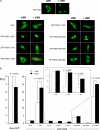CRM1-mediated nuclear export of dengue virus RNA polymerase NS5 modulates interleukin-8 induction and virus production
- PMID: 19297323
- PMCID: PMC2708855
- DOI: 10.1074/jbc.M808271200
CRM1-mediated nuclear export of dengue virus RNA polymerase NS5 modulates interleukin-8 induction and virus production
Abstract
Although all established functions of dengue virus NS5 (nonstructural protein 5) occur in the cytoplasm, its nuclear localization, mediated by dual nuclear localization sequences, is essential for virus replication. Here, we have determined the mechanism by which NS5 can localize in the cytoplasm to perform its role in replication, establishing for the first time that it is able to be exported from the nucleus by the exportin CRM1 and hence can shuttle between the nucleus and cytoplasm. We define the nuclear export sequence responsible to be residues 327-343 and confirm interaction of NS5 and CRM1 by pulldown assay. Significantly, greater nuclear accumulation of NS5 during infection due to CRM1 inhibition coincided with altered kinetics of virus production and decreased induction of the antiviral chemokine interleukin-8. This is the first report of a nuclear export sequence within NS5 for any member of the Flavivirus genus; because of its high conservation within the genus, it may represent a target for the treatment of diseases caused by several medically important flaviviruses.
Figures







Similar articles
-
CRM1-dependent nuclear export of dengue virus type 2 NS5.Novartis Found Symp. 2006;277:149-61; discussion 161-3, 251-3. Novartis Found Symp. 2006. PMID: 17319160
-
Nucleo-Cytoplasmic Transport of ZIKV Non-Structural 3 Protein Is Mediated by Importin-α/β and Exportin CRM-1.J Virol. 2023 Jan 31;97(1):e0177322. doi: 10.1128/jvi.01773-22. Epub 2022 Dec 8. J Virol. 2023. PMID: 36475764 Free PMC article.
-
Nuclear localization of dengue virus nonstructural protein 5 through its importin alpha/beta-recognized nuclear localization sequences is integral to viral infection.Traffic. 2007 Jul;8(7):795-807. doi: 10.1111/j.1600-0854.2007.00579.x. Epub 2007 May 30. Traffic. 2007. PMID: 17537211
-
The Transactions of NS3 and NS5 in Flaviviral RNA Replication.Adv Exp Med Biol. 2018;1062:147-163. doi: 10.1007/978-981-10-8727-1_11. Adv Exp Med Biol. 2018. PMID: 29845531 Review.
-
Inhibition of CRM1-dependent nuclear export sensitizes malignant cells to cytotoxic and targeted agents.Semin Cancer Biol. 2014 Aug;27:62-73. doi: 10.1016/j.semcancer.2014.03.001. Epub 2014 Mar 12. Semin Cancer Biol. 2014. PMID: 24631834 Free PMC article. Review.
Cited by
-
Differential Gene Expression Pattern of Importin β3 and NS5 in C6/36 Cells Acutely and Persistently Infected with Dengue Virus 2.Pathogens. 2023 Jan 27;12(2):191. doi: 10.3390/pathogens12020191. Pathogens. 2023. PMID: 36839463 Free PMC article.
-
RNA regulatory processes in RNA virus biology.Wiley Interdiscip Rev RNA. 2019 Sep;10(5):e1536. doi: 10.1002/wrna.1536. Epub 2019 Apr 29. Wiley Interdiscip Rev RNA. 2019. PMID: 31034160 Free PMC article. Review.
-
Respiratory virus modulation of host nucleocytoplasmic transport; target for therapeutic intervention?Front Microbiol. 2015 Aug 14;6:848. doi: 10.3389/fmicb.2015.00848. eCollection 2015. Front Microbiol. 2015. PMID: 26322040 Free PMC article. Review.
-
How SARS-CoV-2 and Other Viruses Build an Invasion Route to Hijack the Host Nucleocytoplasmic Trafficking System.Cells. 2021 Jun 7;10(6):1424. doi: 10.3390/cells10061424. Cells. 2021. PMID: 34200500 Free PMC article. Review.
-
Antivirals that target the host IMPα/β1-virus interface.Biochem Soc Trans. 2021 Feb 26;49(1):281-295. doi: 10.1042/BST20200568. Biochem Soc Trans. 2021. PMID: 33439253 Free PMC article. Review.
References
-
- Gubler D. J. ( 2002) Arch. Med. Res 33, 330– 342 - PubMed
-
- Lindenbach B. D., Rice C. M. ( 2001) Flaviviridae: The Viruses and Their Replication, Lippincott Williams & Wilkins, Philadelphia
-
- Kapoor M., Zhang L., Ramachandra M., Kusukawa J., Ebner K. E., Padmanabhan R. ( 1995) J. Biol. Chem 270, 19100– 19106 - PubMed
Publication types
MeSH terms
Substances
LinkOut - more resources
Full Text Sources
Other Literature Sources
Research Materials

